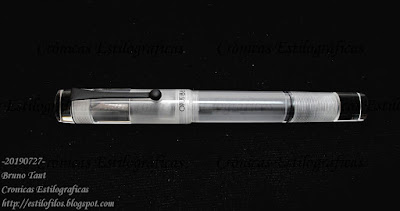Fudefan's take on 2019: https://www.fudefan.com/2019/12/2019-in-review/
Inky.Rocks' video: https://youtu.be/L2M372smNEg ).
A lot might have happened, pen wise- in this year of 2019, but not everything is equally interesting, and each of us has a different view on those. These are my selection and of the relevant events, and my reflections on them.
1. Pen Scene.
2019 was the year of the 100th anniversary of Platinum. This company managed the celebration a lot better than Pilot, whose centenary was celebrated in 2018, but Platinum quickly lost momentum after a promising start.
In Japan, the only new pen released in 2019 was the Pilot Custom NS (the Procyon, let us remember, was released in 2018). The NS is the first steel nib in the Custom family, and its price is about 20% lower than that the Custom 74 with a gold nib. Is this a correct strategy in the Japanese market?
Other than this Custom NS, there have not been any new pen—all there is are rehashed pens, minor cosmetic changes on well known models. The Prime, the Platinum pen to commemorate its 100th anniversary, is little else than a 3776 in silver costume. Sailor, on its side, is mastering the art of generating original models –this is the name they use— to be sold exclusively at a certain shop. It seems a very successful system to raise the attention of customers by creating a false sense of scarcity.

As this, The Prime, is also a 3776 in disguise. The Prime was the pen Platinum released to celebrate its 100th anniversary.
Anyway, not much new.
(The Capless LS has just been released in Japan and barely speaks about what went on along 2019. However, this is something new in the pen scene in Japan.)
In contrast, Taiwanese and Chinese pens are becoming a lot more active and innovative. They are offering new recreations of old filling systems with new models almost every month in the case of pens from the PR of China. Their distribution is also becoming more open and all those pens are easier to purchase.

This Wing Sung, obviously inspired on the Twsbi Vac700, in an example of the activity of many Chinese brands.
2. Ink Scene.
More colors more expensive. And the inflation continues.
The only positive side effect is the surge of small ink companies—Krishna in India, Trouble Maker in Philippines, Three Oysters in South Korea, Kala in Taiwan... But only time will say whether there is enough room for so many people. Or enough customers for so many colors...
But the radical approach to this would be to return to those old colors in unassuming inkwells for about JPY 400 per 30 ml: good and inexpensive ink.

When initially marketed, Irishizuku's inks were very expensive. Now they are among the most inexpensive in the Japanese market. And even cheaper are the regular Pilot inks (the inkwell on the right): JPY 400 (plus tax) for 30 ml. This is the radical approach to the present inflation in inks and their prices.
3. Paper.
Paper, or good quality paper, is also becoming a luxury good. But the production costs might be at the heart of this phenomenon. The paper industry relies heavily on the economy of scale and a small community like that of fountain pen aficionados is unable to generate a big demand. The result--producing small batches to fulfill the demand of such small group is inherently expensive.

"Fountain Pen Friendly Paper Collection", by Yamamoto Paper. Some of those included on this pad are no longer available because some mills are no longer in business.
The alternative, for the time being, could be to go back to old Japanese scholar notebooks, some of which are made of good quality paper, albeit not labeled or advertised as “fountain pen friendly”. Kokuyo Campus, and regular Tsubame notebooks are two obvious options easily available.
4. Events.
The Tokyo International Pen Show (TIPS) is here to stay after a very successful second edition. Its main feature –from my perspective— was the ability of gather people from far away locations. TIPS acted as the meeting point for aficionados from places as far away as Spain and Australia, and that despite being more of a stationery salon than of a pen show.
In contrast, the active Tokyo pen community seems isolated and detached from the rest of the World.
5. Social Media.
I am new to this environment, and I am therefore very naïve –or simply skeptical- about it. However, it is hard to miss the huge activity on social media, and the personal connections created through them. The result is a much better connected pen community where parochial attitudes –like those of Japanese brands- are bound to fail.
Japanese companies have not understood anything related to social media, and behave following patterns anchored in the twentieth century, with segregated and separated markets. They do not seem to understand online shopping across borders.
On the contrary, Chinese and Taiwanese pen companies have embraced this new world and are taking benefit from their constant presence on them.
I am sure there is a lot more that could be said about this year 2019, but this is what called my attention.
WiPens Toledo – Montblanc Irish Green
Bruno Taut
Nakano, December 8th 2019
etiquetas: Japón, China, Taiwan, mercado, evento, redes sociales, Pilot, Platinum, Sailor, tinta
Bruno Taut
Nakano, December 8th 2019
etiquetas: Japón, China, Taiwan, mercado, evento, redes sociales, Pilot, Platinum, Sailor, tinta


























































